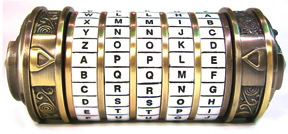X3 (X-Men: The Last Stand)
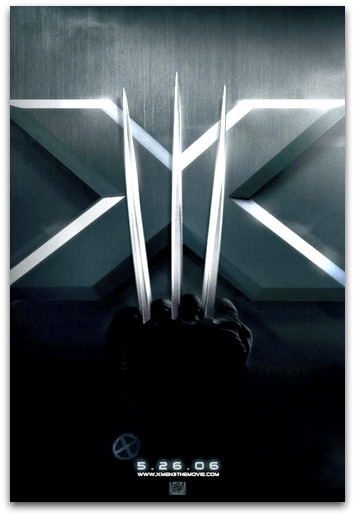
GUEST REVIEW BY ANDREW WELLS
We dodged the bullet with this one.
Given the tortured history and bad blood behind this production (which you can read about elsewhere), the rushed schedule to make the release date, and finally having director Brett Ratner, whose middle name might as well be “vanilla,” X-Men: The Last Stand (hereafter referred to simply as X3) should have been a train wreck of gigantic proportions. And judging from Internet discussion, most everyone thought that was what would happen.
But, miracle of miracles, it’s not. It’s within striking distance of being as good as the other two X-men films. And it is very, very satisfying on its own terms.
Without much detail, the movie deals with two major storylines: the discovery of a “cure” for mutants and the return of Jean Grey, who has now become the Phoenix. There are also nods to other storylines and characters, most of which I am not familiar with. But one of the things I have most enjoyed about the X-men movies is their ability to take these characters and storylines and refashion them into a successful mythology of their own. You may have needed to see the other movies, but you needn’t have read the comic books.
Having said all that, here are my other thoughts about the movie:
--One of the things I was most worried about having a new director for X3 was the loss of tone. X-Men and X2 both have a moody, sometimes ambivalent outlook about what is happening to the characters and to their world. The tone really makes the movies work, because these characters are far from perfect, and so is their world. Happily, the tone is still there. Perhaps the best example of it is the scene where Beast and Wolverine look at each other while fighting Magneto and Pyro. They know what they have to do, but they wonder if ethically it’s the right thing to do. They don’t say a word; you can read everything in their eyes.
-- Ethics play a large part with Magneto as well, and thanks to Ian Mckellen’s performance, he remains one of the most interesting characters in the movie: he’s right about what the cure will mean for mutants, but his believed superiority over humans robs him of the humanity he needs. You can see this in his final scene with Mystique, where his response to her is as stone cold as it gets. And his final scene at the chessboard, reflecting on everything he has lost and won, is very moving.

--As to the other actors, most everybody does really well to distinguish themselves, with two exceptions. It doesn’t matter how much fur Beast has; every time you hear him open his mouth, it’s Fraiser Crane, a.k.a. the actor Kelsey Grammer. He’s very good in the role--his fight scenes rock--but the character is just too similar to what he’s played for twenty years. The other exception is Halle Berry, who should never have been in the X-men movies in the first place. For an African weather goddess, her accent bounces around more than a pinball, and she’s never had the majesty that I thought was essential to Storm. I’ve always thought Angela Bassett would have been a better choice, and I still believe it.

--I was also pleased about the continuity from the previous two movies. They got the minor actors (like Daniel Cudmore who plays Colossus) to come back, and they make good references, like Wolverine asking Rogue if she needs a lift. And I like the chess allusion that Magneto keeps using—touches like that really add to the quality of the movie.
--The production was rushed, but you can only see it in the special effects. Most look great, but there are several scenes where I was just taken out of the movie completely, most notably when Jean leaves the lab and when Wolverine approaches Jean on Alcatraz Island. And why have that great shot of Magneto throwing that rig through the windshield in the movie trailers, but not in the movie?
--And finally, obviously, it’s not the last stand. They’ve made too much money on this not to try again, and the story leaves too many characters' fates in question. Having said that, I think the movie could have benefited from a few more minutes, especially the Rogue/Iceman/Shadowcat storyline. We don’t get to see how that plays out, and it seems unfair. But given how much the movie got right, and how satisfying it was--the best movie experience I’ve had in a good while--it seems trivial to complain about.
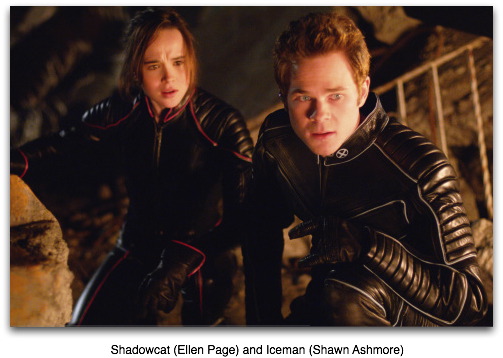
ANDREW WELLS can be contacted at arwell012002@yahoo.com
RICK'S COMMENTS:
There's not much for me to add here, Andrew--great review as always. I don't think I was ever as pessimistic about this movie as some folks were. However, if Brett Ratner's work has proved disappointing to some in the past, he has definitely redeemed himself in this film. In fact, this may very well be my favorite of the trilogy. There was so much action and so many characters, this movie felt like more of the comic books than either of the previous two installments. Who knows--maybe Singer had been holding back on us. I personally liked Grammer as Hank McCoy--more than you did, evidently. Hank McCoy/The Beast is supposed to be an extremely intelligent individual, so I think Grammer's background in "egghead" roles helped with this character, and that was probably why he was cast.
One question, though Andrew-- Angela Bassett as Storm? How old is Storm supposed to be?
Geekish nitpicks--in the comic books, McCoy's blue fur and skin are not part of his mutant characteristics, but rather from his own experimentation on himself. Therefore when he reaches out his hand to the "Leech," his fur should not have disappeared. However, his agility, strength and animal like reflexes are mutations. Incidentally, there was a brief Hank McCoy cameo in X2, where he was played by Steve Bacic, without the blue skin and fur. And although I thought it was really cool to see the Juggernaut in this movie (Vinnie Jones was perfect, accent and all), am I not correct that Juggernaut is not a mutant? I know, I know--it's all simplified for the movies.
Three quick notes:
(1) This movie is incredibly violent. Parents should take note of this before taking small children. Blood is tactfully (and perhaps unrealistically) avoided, but lots of people get killed. I remember at one time, Total Recall held the record for 140 or so deaths. This movie would have to be close to that from what I saw.
(2) If you get up and leave before the credits are over, you will miss the final scene.
(3) This is completely trivial, but in the scene where Wolverine is on his knees in front of a grave (I won't say whose grave), if you look on the left shoulder of his jacket (on the right side of the screen), there's a GIANT spider that has absolutely nothing at all to do with anything in the movie. I'm surprised it wasn't edited out. But just think-- what if it had been a radioactive spider? Then we could have had "Spider-Wolverine-Man."
Logos Bible Software for the Mac Delayed Again?
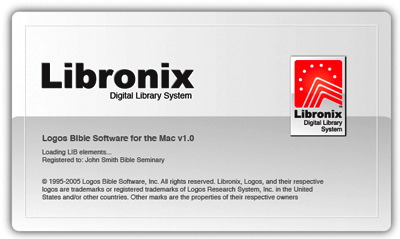
In March of 2005 Logos Bible Software announced that it was porting its software including the massive Libronix Digital Library to the Macintosh. The original estimated ship date was to be by the end of the year. In fact, signs at the November 2005 ETS and SBL meetings sported the message, "Mac Lovers. It's Here." However, as is often the case when porting Windows software to the Mac, the project proved more daunting than originally thought and so the release date was pushed back to Spring 2006 with the statement, "We're confident that the product will be shipping by the time June 21 rolls around, and we know it will be worth the wait." Fair enough. These things take time, and whoever makes their initial ship date anyway?
Logos has an email list that Mac users can sign up for regarding updates on progress for the Mac version. Since the June 21 deadline is now less than a month away and because I had not heard anything from Logos about the Mac version either by email or on their blog in quite some time, I emailed them last week asking if there was any kind of update or if there was an official ship date yet. I was hoping to hear that the program would still ship by June 21. However, in an email I received from Kathy Burkleo from Logos Support on May 25, not even the ship date of June 21 was confirmed. Burkleo simply stated, "At this time we still do not have a definite release date for the Mac version as it has taken longer to produce than originally anticipated." Wow.
In an attempt to get clarification about the June 21 deadline, I emailed Burkleo back asking, "Last I heard, it was going to be in the Spring. Is this no longer a a target date (as we're a month away from summer)?" She responded simply with "Again, we have not been advised of a release date since it is taking longer than originally anticipated to produce the program."
The fact that Logos has been extremely silent about the Mac version in the last few weeks and Burkleo's inability to even confirm the release deadline leads me to believe that we may be waiting longer than June 21. If this date was still a realistic target, I would have thought that Burkleo would have confirmed it.
On one hand, that's okay with me as I'm not waiting on Logos for the use of their Bible software, proper. I've been an Accordance user since 1998 and have no plans to stop using it just because Logos releases its Mac version. However, Logos has an impressive library of electronic texts not available in Accordance. After the announcement of the forthcoming Mac version last year, I purchased a couple of electronic texts from them with their promise that I would be able to run them in the Mac version of Libronix as soon as it was released. I now have about four texts total, but I am forced to run them in the Windows version via VirtualPC which is never a pleasant experience.
Hopefully, Logos will update us soon about their upcoming Mac version.
Update 11 PM: As mentioned in the comments, I have confirmed that according to the Logos Mac page, the product has indeed quietly been postponed until this Fall.
New Arrival at the Smith Home

Congrats to Troy and Wendy on the arrival of their new little girl, MADISON FAITH. She was born on May 27 at 10:07 AM in Louisville, Kentucky and weighed 7 lbs, 11 oz. and was 21" in length.
Be sure to visit Babynet at Baptist Hospital East to leave Troy and Wendy a word of congratulations.
The Holman Christian Standard Bible (Top 10 Bible Versions #1)

The late 19th Century saw two major projects to update the King James Version: the (British) Revised Version of 1885 and the American Standard Version of 1901 in the United States. In spite of the improvements made upon the KJV, neither of these revisions saw much attention outside academic circles. A number of English translation projects were introduced in the first half of the 20th Century including those by James Moffatt (1935) and Edgar Goodspeed (1927). However, the only real modern translation to make any kind of inroad into Protestant Bible reading in this era was the 1952 Revised Standard Version, a substantial update to the 1901 ASV. Yet, even then, most Christians continued to preach and read from the King James Version.
The 1970's however, would signal an explosion in modern translations beginning with the New English Bible (1970), The Living Bible (1971), the New American Standard Bible and RSV II (1971), Today's English Version (1976), New International Version (1978) and the New King James Version (1982). Of this generation of English translations, two Bibles distinctly stand out. The Living Bible is significant in that not only was it an extremely popular paraphrase, but more importantly, it was the first Bible to unseat (for a time) the KJV as the highest ranking in Bible sales. The second Bible of note from this era is the New International Version which was able to sustain a top ranking in sales for the most part over the last two decades. The NIV, like the TEV was a brand new translation, not in the Tyndale/KJV tradition. Moreover, like the TEV and NKJV, the NIV was completely free from archaic vocabulary unlike the RSV II and NASB, which still used "thee" and "thou" when referring to deity. And most significantly, it was during this era that most Christians started to read modern translations--that is, something besides the venerable old King James Version.
In my opinion we are now in a second major generation of translations since the 1970's. I would date this era as beginning in 1989 with the publication of the New Revised Standard Version. This era has also seen an update to the New American Standard Bible (1995); the New Living Translation (1996 and 2nd edition, 2004); a more conservative alternative to the NRSV, the English Standard Version (2001); a paraphrase, the Message (2002); the Holman Christian Standard Version (2004) and the Today's New International Version (2005). A record number of other translations have appeared in this era as well--some better than others--but in my opinion, these that I have listed are the most significant versions. This current generation is marked by two things. First, in this group all archaic language has been dropped. Secondly, the debate regarding inclusive language referring to human beings has taken front and center stage. All of these translations are more inclusive than those of a generation ago, but the NRSV, NLT, Message, and TNIV are more overtly so.
And of this group, the HCSB stands out as the first completely new committee-translated Bible version since the NIV of 1978.
HISTORY. What would become the HCSB started as a project of Dallas Theological Seminary professor, Arthur Farstad. Farstad had previously served as editor of the New King James Version (1982) and co-editor of The Greek New Testament According to the Majority Text. From what I can gather, Farstad wanted to do a brand new translation, presumably outside the Tyndale/KJV tradition. All the sources I've read claim that Farstad wanted to base this translation on the same NT manuscript tradition underlying the King James and New King James Versions (the Textus Receptus). I've often wondered if this is accurate though. Was Farstad working on a translation based on the TR or the Majority Text? To me it would make sense that he would have been working on a translation based on the latter, especially since--as I have said before--there's not a major translation based on the Majority Text.
Regardless, Farstad worked on his project from 1984 until 1998 when Broadman and Holman, the publishing arm of the Southern Baptist Convention offered to financially support the project and retain ownership of it. The SBC was looking to sponsor a translation of its own to use in Sunday School literature and related publications so that it would no longer have to pay licensing fees to use the New International Version. In the same year that the deal was struck, Farstad died. After his death, the editorial responsibilities were turned over to another committee member Ed Blume and the underlying NT text was switched mid-project to the NA27/UBS4. Frankly, I am glad the text was switched because I would have hated to have seen an "official" SBC translation based on either the TR or the MT. I would have certainly not been interested in the HCSB if it had continued on this path, and it wouldn't be on this list. I'm not hiding my textual bias.
Personally, I have a number of questions I've never seen addressed anywhere. First, I am curious about the actual text Farstad was using as I have mentioned above. Was it really the TR, or was it in fact, the Majority Text? Secondly, I wonder why the project went on for fourteen years without any publication. Then as soon as Broadman & Holman took over the project, they changed the textual basis and published the four gospels the very next year (1999). What exactly made the difference after the committee regime change that resulted in such quick publication? Third, and this is just an insignificant curiosity, I wonder what the project was called before the SBC sponsorship. Was it simply referred to by the committee as the Christian Standard Bible?
The complete Holman Christian Standard Bible was published in 2004. A number of various editions exist, but as of this writing, it is not yet available in any true "study" editions.
Why I like the HCSB. From 1986 to 2005, the primary (but never exclusive) translation I used for study and teaching was the New American Standard Bible. I will give credit where credit is due, and will acknowledge the fact that it was the influence of Wayne Leman and the other contributors of the Better Bibles Blog that caused me to question my continual use of the NASB in public. I've never thought there was one Bible that fits everyone and every context. I knew that the NASB, which is perhaps the most literal of the major translations, could at times come across as a bit awkward in its phrasings, but I had used it for so long that I believe I tended too easily to overlook certain aspects that frankly, just didn't communicate that well. This especially came to light when I spent roughly half a year (26 weeks) systematically walking a Sunday School class at my former church through Paul's letter to the Romans. In the course of this study, I realized that I was spending too much time trying to bridge the gap between the NASB and the people in my class.
After moving to a different county and joining a church within walking distance of our home, I was asked to teach a class at my new fellowship. However, I decided to make the momentous leap from the NASB to...well...something else. As many of you know, I collect translations and had eighty-something to choose from. But I purposefully narrowed my choice to that second-generation list of modern translations that I described above, and obviously, I eliminated the NASB update as that's what I had been using since 2002. Finally, I narrowed my choices down to the HCSB and the TNIV. Both are good translations, and both are in my top ten picks. In the end, I decided to go with the HCSB simply because that's what was in the Sunday School literature at our church. Although I certainly encourage participants in my class to bring their own copy of the scriptures, when they don't, at least what I read from is identical to what they have in their Sunday School book. But there's more to my liking of the HCSB than simply its inclusion in the Sunday School literature.
I'll admit that as far as translations go, generally, I prefer a more literal translation--or perhaps what is usually referred to as a formal equivalence translation. However, I also recognize the weaknesses in this translation philosophy. The introduction to the HCSB makes the claim that the translators used a method known as "optimal equivalence." Now, I'll admit that when I first read this term a few years back, I laughed out loud. I thought that the translators were essentially creating another term for some kind of dynamic equivalence method. However, upon closer inspection, I discovered that's not the case. To put it in my own words, optimal equivalence seems to start with a formal equivalent method; however, if formal equivalence does not communicate the biblical meaning of a text to a contemporary audience, the translators feel free to use more dynamic, or idiomatic, methods to get the message across. The more I've read the HCSB, the more convinced I've become that this really seems to work. What the HCSB ends up becoming is a translation that is fairly literal, but without all the awkwardness of a formal equivalent translation. It's readable like the NIV, but in my opinion, much more precise than the NIV.
I've read completely through a number of Bible versions, but I've said before that I don't think you really get to know a translation until you study with it. As I've studied with the HCSB over the last few months--alongside the Greek text and the NASB--I've been surprised, and even delighted with the precision of the HCSB. As some of you know, I returned to school this past Fall to pick up my degree where I left off a number of years ago. This past spring semester, I audited a doctoral-level Greek seminar as a refresher. As I translated the prison and pastoral epistles, I checked my own translation of the text not just with the NASB as had always been my practice in the past, but added the HCSB to the mix. In comparing the Greek text, my own translation, the NASB, and the HCSB, I became more and more convinced that the HCSB better conveyed the biblical meaning than the NASB. Certainly, there were places where the NASB was more literal, but is accurate translation evaluated more on word-for-word accuracy or on the ability to get the biblical writers' meaning across in the most effective manner?
Another enjoyable aspect of the HCSB is that it's not in the Tyndale/KJV tradition. Of course, neither is the NIV, but I never really bonded with the NIV. As stated above, the HCSB is the the first major translation in the last twenty-five years that is completely new and not an update of a previous version. As such, the translators had the courage to break free from familiar, but incorrect renderings of the past. I have previously blogged about the HCSB's correct translating of passages such as 2 Tim 1:12. Most new translations have generally left extremely familiar passages as is because in evaluating a new Bible version, the average person turns to these familiar passages first. But some of these passages needed correcting. Take for instance the 23rd Psalm. In v. 4, the KJV, NASB, NIV, and ESV all refer to "the valley of the shadow of death." Yet, this is over-translation. Most who are familiar with the Hebrew text will tell you that there's really nothing in there about shadows or death. But it's all quite poetic and it was read that way at Aunt Martha's funeral, so most translations have left it alone other than putting the actual phrasing down in the footnotes. Not so with the HCSB which renders the verse, "Even when I go through the darkest valley... ."
Of course the most controversial correction has to do with the HCSB's rendering of John 3:16. Years ago, the NIV translators correctly opted to translate μονογενής as "one and only" instead of "only begotten" which had remained standard phrasing in translations of the Tyndale tradition. However, the HCSB translators went a step further and corrected the "so" of "God so loved the world... ." The average person reads the "so" in John 3:16 as meaning "God sooooooo loved the world that he gave his only begotten son" or that "God loved the world SO MUCH." Now, I won't deny God's perfect love for his creation, but that's simply not what the "so" means. The "so" is from the Greek word οὕτως and simply means "thus" or "in this way." In other words, to paraphrase, what the verse means is "This is the way in which God loved the world: that he he gave his one and only son... ." The HCSB renders John 3:16 as "For God loved the world in this way: He gave His One and Only Son, so that everyone who believes in Him will not perish but have eternal life."
The HCSB also brings in line verse divisions with that in the NA27/USB4 Greek text. Years ago I memorized Gal 2:20 in the NASB from a Navigator TMS card which read "I have been crucified with Christ; and it is no longer I who live, but Christ lives in me; and the life which I now live in the flesh I live by faith in the Son of God, who loved me and gave Himself up for me." Yet, when I sat down with the HCSB a few months back to look up my familiar passages, there was nothing about being crucified with Christ in v. 20. Instead, I found that part in the preceding verse: "19For through the law I have died to the law, that I might live to God. I have been crucified with Christ 20and I no longer live, but Christ lives in me. The life I now live in the flesh, I live by faith in the Son of God, who loved me and gave Himself for me." I wondered why the break was made this way and discovered that it is this way in the Greek text. The NRSV also makes the division here, but the other modern translations follow the traditional verse divisions. Since then I have found a consistent pattern in the HCSB to defer to the verse divisions in the Greek text when traditional divisions differ.
To me, the HCSB embodies not only accuracy in translation, but also a freshness in the translator's approach to the text. As I said before, there are sometimes certain renderings that just absolutely delight me. I wrote a few weeks ago about my discovery of the HCSB's use of "slacker" for "lazy" (רָפָה) in Exodus and "sluggard" (עָצֵל) in Proverbs. Even the TNIV uses "sluggard," but which word speaks better to a contemporary audience? In my blog about the HCSB's use of "slacker," one commenter suggested that such a word was slang and would unnecessarily date the HCSB. However, I disagreed because the word has been around almost a century, originally referring to someone who shirks military duty and later having a much broader meaning.
Another feature I really like in the HCSB is the use of "Bullet Notes." Included in the back of most editions of the HCSB is a list of definitions for certain words used throughout the Bible. One common difficulty of translating a text from one culture to another is how to communicate inherent jargon. Certain words carry very specific definitions, but the problem often faced by a translator is that the reader may not know or understand a particular word. Usually this will result in a compromise on some level, often with a translation opting to use a simpler, but less specific term. The use of bullet indicators next to certain words allow the translators to keep very specific terms in the text. Noting that the HCSB translators opted to keep a very theologically loaded term like propitiation, instead of the simpler "sacrifice of atonement" as in the NIV and NRSV, I wrote to the editors of the HCSB in February asking why there wasn't a bullet note for this term. I received an email back stating that bullet notes were being added for both propitiation and redemption, and these will show up in future editions of the HCSB.
What could be improved with the HCSB. In spite of the precision in translation that I mentioned earlier, there are still some places in the HCSB that seem a bit clumsy now and then. And I often wonder why a particular word choice was made. Why, for instance, did the translators opt to use the word deluge instead of the much simpler flood in the Noah story in Genesis? What exactly does deluge communicate that flood does not? I think I would feel like something of an egghead to announce I would be speaking on "Noah and the Deluge."
The HCSB uses "small lower corner brackets ... to indicate words supplied for clarity by the translators." Although this is an improvement over the use of italics for this purpose as in the NASB, the very nature of optimal equivalence makes the entire practice unnecessary and distracting.
Another problem with the HCSB is that the translators chose to capitalize pronouns referring to deity. In most passages, the pronouns are pretty clear, but not in all. A case in point is Micah 7:14 which was part of a larger passage covered in the Lifeway Explore the Bible Curriculum for May 28. The HCSB capitalizes the pronouns, rendering the text, "Shepherd Your people with Your staff, the flock that is Your possession." Thus, the way the pronouns are capitalized, it would lead one to believe that this is a prayer to God from the prophet Micah. But is this the case? Ironically, in the actual SBC curriculum, the writer took the passage much differently suggesting that this was God's commands to earthly kings. Therefore, the curriculum writer disagreed with the HCSB, both of which are from the same publisher. I agree with the writer, but the translators' decision to use capitalized pronouns creates unnecessary problems.
Although I like the decision to use Yahweh in places for the name of God as opposed to the all-caps LORD, I would prefer that Yahweh would simply be used throughout the Old Testament. Why should God's proper name be used in Psalm 68:4, but not in Josh 24:14-28 when Yahweh is being set in distinction to all the pagan gods? One of the reasons I like the New Jerusalem Bible is the decision to use the actual divine name throughout the OT text.
I'm certain that we'll see the HCSB in a variety of editions. In my opinion, once a translation appears in various study Bible editions (even though I, personally don't tend to use them), it has reached a significant level of public acceptance. But I would also like to see academic resources such as an HCSB/Greek text diglot. Zondervan has been very good about doing these kinds of products with the NIV.
Although the HCSB currently outsells the ESV, Broadman & Holman could learn a few lessons from Crossway's ESV marketing handbook. I've suggested on their feedback page that Broadman & Holman start an HCSB blog. They responded by saying they would consider it. I see lots of "ESV: Truth Unchanged" badges on various websites, but there's no HCSB equivalent for bloggers who like this translation. Although there was lots of promotion around the launch of the HCSB, it seems to have died down a good bit in recent months.
The HCSB also needs to branch out beyond SBC circles. Although I said I am certain that the HCSB will appear in various formats, will we ever see something like an HCSB Life Application Bible published by Tyndale Press? Unfortunately, when I've recommended the HCSB, I still sometimes hear it referred to as "the Baptist Bible" or "the Lifeway Translation." This is in spite of the fact that according to the HCSB FAQ, only 50% of the 100 or so members of the translation committee were Baptists, and 17 different denominations were represented in that team.
How I use the HCSB. Currently, the HCSB is my main Bible for teaching in church settings. I also use the HCSB in my personal Bible study in comparison with the original languages and other English translations. The HCSB is currently the translation that I am reading through.
What edition of the HCSB I primarily use. I've been teaching from a genuine leather edition of the HCSB known as The Ministers Bible (ISBN 1586401696). I bought this edition primarily for its single-column format which is handy for writing in my own notes. There are also a number of useful ministry helps including two separate wedding ceremonies, a funeral sermon, pre-marital counseling guidelines, and a host of other resources. Personally, I think these resources should be in the middle of the Bible, perhaps between the testaments instead of in the back. If you were to actually use this Bible to read wedding vows from, it would be simpler to hold your place in the middle than in the last few pages. And speaking of pages, they are way too thin in this edition and tend to curl after writing on them. An attempt was made to create a quasi-thinline Bible, but I would prefer thicker pages in exchange for a thinline form factor that doesn't mean that much to me.
For Further Reading:
General
• David Dewey, A User's Guide to Bible Translations, pp. 192-194.
• HCSB: Wikipedia entry
• HCSB Official Site
• HCSB FAQs
• HCSB Translation Team
• Wayne Leman's HCSB Links Page
Analysis
• HCSB: Bible Researcher Page
• HCSB: Better Bibles Blog Page (see especially comments)
Up next: The TNIV's All Right With Me.
So Dark the Con of MAC (The Apple Computer - Da Vinci Code Connection)
Freudian Haplography?
The head monk, says, "We have been copying from the copies for centuries, but you make a good point, my son." So, he goes down into the dark caves underneath the monastery where the original manuscripts are held as archives in a locked vault that hasn't been opened for hundreds of years.
Hours go by and nobody sees the old abbot. So, the young monk gets worried and goes down to look for him. He sees him banging his head against the wall and wailing, "We missed the "R," we missed the "R." His forehead is all bloody and bruised and he is crying uncontrollably.
The young monk asks the old abbot, "What's wrong, father?"
With a choking voice, the old abbot replies, "The word was celebrate."
Top Ten Bible Versions: A Few Introductory Words
Regardless, I'm not all that upset that I haven't been able to abandon translations for the original languages. On one hand, besides the naive assumption that I would ever be able to read exclusively from the Greek and Hebrew, there was also an assumption that I would be able to create meaningful translation on the fly in front of a group. If you've ever attempted to do this, you know it's easier said than done.
On the other hand, I really enjoy reading and comparing translations of the Bible. Precise translation excites me. Clever translation impresses me. I read through translations devotionally. I began collecting translations years ago, and frankly I can't imagine ever being at a point where I would not be using them and interacting with them--regardless of any level of proficiency with the original languages.
People get quite attached to translations of the Bible. There are KJV-only people for instance. Some are KJV only because they think that's the original Bible and it holds some special divine authorization. Others are KJV-only because they hold to the Textus Receptus manuscript tradition. Although, I'll be honest--I've never quite understood why those who hold to the Textus Receptus don't favor the New King James Version over the KJV. Most whom I've known who claim allegiance to the TR still favor the KJV. I've also known some who hold to the Majority Text, but what version would they use then? There's actually no major English translation based on the Majority Text, so most of them will still use the KJV. And of course, some hold on to the KJV simply because they like it best. It's this latter form of KJV readers that seem a bit more palatable.
A few years ago when I was in my twenties, a pastor took me under his wing and began incorporating another seminary student and myself in the worship services, letting us preach regularly or read the Scripture passage for the week. This pastor was older and exclusively used the KJV in his messages. However, my friend and I always read from the NASB or NIV, and we had never been told to do otherwise. Then we had a member who had been active for decades decide he was leaving the church because we were reading from a translation other than the KJV. It turns out that when he was a young man and the then-newly-published Revised Standard Version was giving cause for controversy, he made a vow to never read or allow to be read to him a different translation than the KJV! The pastor tried to reason with him, as did the head of the deacons. But he refused to budge. He had made his vow to God, by Jephthah! I was certain that the pastor would cave and tell us from now on to use the KJV, but to my amazement, he decided to let this member go. I've always had great respect for him because of that.
Anyway, it makes me wonder if in a few decades we'll see NIV-only or ESV-only adherents. I'll admit that I went for twenty years studying and teaching exclusively from the New American Standard Bible. Yes, as described above, I appreciated other translations, and other translations interested me, but overall I was convinced that the NASB was the best translation, period--for me, for you, for everyone. I didn't necessarily voice that sentiment, but my actions demonstrated it. Obviously, I no longer think that way, but I'll talk more about that when I get to the entry on the NASB.
Yet, I've never belittled anyone for using a particular translation or accused someone of having aberrant beliefs based on what version of the Bible he or she used. I'm greatly disturbed that Evangelicals are arguing with each other over translations of the Bible, particularly the TNIV which isn't even on the June top ten list from the Christian Booksellers Association (see below). In fact, if you look at that list, all the English translations represented are Evangelical translations. We read the Bible more than any other group in all of Christendom if these figures are any indication.
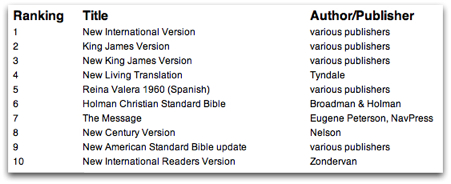
To say that "The best translation is the one you'll read" might sound cheesy to some, but I really believe that. I have 84 distinct English translations, and off the top of my head, there are only about two that I would seriously not recommend under any circumstances (the New World Translation and the Inclusive Version NT). Some are obviously better than others. I believe I can make a case as to why newer translations in general should be favored over older translations. But hey, if the KJV speaks to you, reading that is better than reading nothing. However, people get really upset over translations, even translations that are being read by others. It's not like anyone makes you read a particular translation. Right now, the TNIV seems to be the negative target of choice, and I really believe the issue is totally overblown. I'll explain more when I write my entry on the TNIV.
If you read my initial post where I announced this series and the top ten versions I am going to write about, you'll notice in the comments where people question WHY I didn't include this or that translation. It's my list, for the love of Margaret! Others are free to write their own list.
Regardless, I may have made a mistake in ranking these from 1 to 10. The first three probably are truly ranked in my mind in terms of my use and admiration of them. However, think of all of them as categorical favorites. The Revised English Bible has some of the best literary qualities, especially for oral reading, for instance. The Wycliffe New Testament is one of my favorite Bibles in the historical translation category. The New American Standard is my favorite formal equivalent translation in the Tyndale tradition. The Message is my favorite paraphrase. You start to get the idea.
So here we go. All of these blog entries are my subjective takes on why these particular Bible versions stand out to me. The exclusion of any particular translation is not a knock against it. Don't take it personal! I'll begin with the Holman Christian Standard Bible followed by the other nine in my list and a few honorable mentions to boot.
By the way, in case you missed it, these are the versions that I'll be covering:
1. Holman Christian Standard Bible
2. Today's New International Version
3. New American Standard Bible
4. New Living Translation
5. The Message
6. Revised English Bible
7. New Jerusalem Bible
8. Good News Translation (Today's English Version)
9. The Wycliffe New Testament (1388)
10. Modern Language Bible (New Berkeley Version)
Honorable Mention #1: New English Translation
Honorable Mention #2: King James Version
Honorable Mention #3: The Cotton Patch Version
Redacted 5/23, 10:00 AM
Believe it or Not
| You Have A Type B+ Personality |
|
You're a pro at going with the flow You love to kick back and take in everything life has to offer A total joy to be around, people crave your stability. While you're totally laid back, you can have bouts of hyperactivity. Get into a project you love, and you won't stop until it's done You're passionate - just selective about your passions |
New Superman Returns Trailer
There's what appears to be a new (third) trailer out, but it's not on the Quicktime site as of this writing.
Enjoy.
Oh, and that very last scene in the trailer--Ouch! And then, OH MY!
Whatever Happened to Christian Music?
About twice a year or so, I break out some of my older music albums. I have been listening to music since around 1988, so I’ve been through a lot of music. This time around, I pulled out some old Petra (the Greg X.Voltz era, for those who remember) and, well, it rocked. Rocked hard, both musically and lyrically. “Chamelon”; “More Power to Ya”; “Get on Your Knees and Fight Like a Man.” What great music!
So what is the last Petra song I heard on the radio? “Lord I Lift Your Name on High.” A praise song with a more pop-oriented sound. Catchy, but nothing distinguished. And I have heard this song covered by at least a dozen artists, not to mention in church all the time. A far cry from “Why Should the Father Bother?” Maybe hearing the current Petra is okay for some, but for those with a longer history with the music, they are probably asking the same question I do every time I walk into a the Christian music section: What happened?
Christian music may be selling more and more product, and getting wider recognition, but musically and lyrically, it is in a huge creative slump, I think. I would love to listen to more Christian music, but I find it bland and boring (with some exceptions).
Most of the problem is that Christian music is a business, even if the industry’s goal is to honor Christ and shine a light on Him. And as the music business follows trends, so does Christian music. That is why there are so many praise and worship albums out and a bunch of younger bands doing what Petra is doing—making music that sounds the same as everybody else.
Please understand: there is nothing wrong with praise and worship music. Worship is an important part of the Christian life, and music is helpful in that point. And many of the contemporary praise songs are wonderful. But like anything else, I think it can get monotonous. For example, the only contemporary Christian radio station in my area (Columbia, SC) plays pretty much only praise music. Furthermore, they let listeners determine what they want to hear through Internet voting, so they play pretty much the same few songs by the same artists, and rarely play anything new. If you listened to this station without knowing anything, you’d think Steven Curtis Chapman stopped making music after his Speechless album (from 1999), that Mercy Me and Casting Crowns vanished after their big hits, and that Petra, the Newsboys and Third Day have never done anything but Christian music. Not every station is like this, I know, but it is frustrating.
There are artists past and present who are swimming against the tide, but the nature of the marketplace has driven them to the margins or out altogether. Charlie Peacock is the Paul Simon of Christian music; I know he is still making music, but I cannot find his albums anymore. Iona is a wonderful Irish/Celtic group that does albums around Christian themes; they do not even release albums in America anymore, and have not toured here in years. Sara Groves writes challenging, intimate songs about our relationship with God; I can find her in stores, but not on the radio.
But what really makes me sad is the loss of a lot of good artists. Steve Camp writes provocative songs in the spirit of Keith Green, but his uncompromising views have pushed him out of mainstream Christian music. Steve Taylor music was so eccentric with his music that he left the business entirely. Wayne Watson, Sandi Patty, Julie Miller, Kim Hill, Wes King, Phil Keaggy, Margaret Becker, Mylon Lefevere, Dallas Holm—the list goes on and on. And many record companies have let albums go out of print, so Christian music lovers cannot even check out musical history. Anyone seen a Degarmo and Key album lately? The 77s? Randy Stonehill? Whiteheart? Michael Card? Russ Taff? First Call?
As to the other problem—everyone making music that sounds the same—that is a common problem throughout Christian and secular music, both past and present. The market takes care of itself in some ways, eliminating some and leaving others (Crumbacher, anyone?). Furthermore, I would hope that any Christian musician(s) would be in the business for ministry and honoring God, and nothing else.
Certainly, God has given abundant talent to people who serve in music ministry, both in and out of church. And for many audiences, there is a certain comfort in the familiar. I do not know if there is a solution to the problem I am describing, but I would encourage people to look at Psalms for inspiration. Those poems and songs are about a lot more than praise—they cover every aspect of the Christian experience, and can be extremely challenging, convicting and inspiring. And finally, we must remember that God will put His message in the mouths of those He sends out, just as He did with the prophets and the disciples.
Andrew Wells can be reached at arwell012002@yahoo.com.
The Da Vinci Code (Movie): A Brief Review
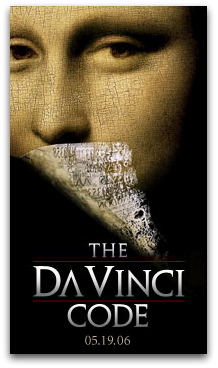
I have no desire to write a full review of The Da Vinci Code. Everyone seems to be doing that, and most of the reviews are not that upbeat. Here are a few quick thoughts:
I'll be honest, bad theology and bad history aside, the book itself was a pretty good read. Dan Brown made you like the characters, especially Langdon. However, as is often the case, the movie just isn't as good as the book. The movie seems to me to be much darker than I remember the book. The book seemed--dare I say it--fun at times. This movie is not fun.
Robert Langdon will not be a memorable role for Tom Hanks. The movie version of Langdon is fairly two-dimensional and Hanks doesn't seem to have much freedom to expand the character in any given scene. Ian McKellan has the best lines and perhaps creates the best performance. In light of the actor's publicly stated animosity toward the Judeo-Christian tradition, his rant against Christianity toward the end of the movie is very believable.
This may be the only movie to ever reenact the Nicene Counsel. Of course, it's depicted as pure chaos.
I'm not sure if this movie will appeal to those who aren't already interested in the subject. In other words, if a person had no desire to read the book, will he or she go see this movie? Related to that thought, had I not read the book, I would have had great difficulty following certain plot points. Distinguishing between the Priory of Sion and Opus Dei would be a challenge for the uninitiated, in my opinion. And there were a number of scenes where the only reason I could follow the story was because I remembered the sequence of events in the book.
And here's a minor spoiler (look away if it's really an issue for you). What happened to the guy getting the girl? In the book, there's a kiss between Langdon and Neveu that definitely has romantic implications, and a promise is made to see each other again at a planned time. In the movie, there's no such kiss and only a vague promise to see each other again. What happened? Well, perhaps the director, Ron Howard, recognized while filming the picture that there just wasn't a whole lot of chemistry between Hanks and Tautou. Blame the casting director perhaps. Hanks was certainly not the first choice for this movie according to the Internet Movie Database, but I'm not sure anyone would have fared better. However, don't you wonder if there were two different endings filmed?
Personally, if I were Langdon, I would have qualms against becoming romantically involved with the living descendent of Jesus Christ. But maybe that's just me. And I guess if Jesus had descendants, he's really not the Jesus of the Bible, and we could agree that this is a major point of the movie anyway.
Finally, there's a scene at the end of the movie, which doesn't seem to be in the book at all, but perhaps was added because of all the controversy (I'm trying to find the exact dialogue, so maybe I'll come back and update this). Anyway, in one of the final scenes, Langdon says to Sophie, something to the effect, "It's up to you what you believe." And then, "Does it matter if Jesus was human or divine, since he's remembered for teaching love and peace?" Those aren't the exact words, but you get the idea.
Two problems. It does matter what you believe. Truth is not relative. And the theological problem in both the book and the movie is that it creates a false dichotomy between the divinity and humanity of Jesus. Was he a man or was he a God? It's not an either/or. The Bible presents it as a both/and.
Truth be told, I'm a bit weary of The Da Vinci Code. I'm teaching on it Sunday and Wednesday nights because I believe it needs to be addressed within and outside the church. However, based on the response I've heard from a number of Christians who have pondered if the claims in the book might possibly be true, I believe we may need to change our discipleship strategies a bit in our churches. That will be the subject of another blog in a few days.
As films go, If you want a better movie in this genre, go rent National Treasure. Lots of puzzles and codes, better acting and plot, more historically accurate, and much less offensive.
Redacted 5/21, 7:40 AM
10 Tips for College (and the Rest of Life)
Here's my outline:
"10 Tips for College (and the Rest of Life)"
Supporting Text: Psalm 121
1. Guard your heart (Prov 4:23).
2. Get involved in campus life (and community/neighborhood/church life).
3. Don’t get in debt.
4. Plan for the future, but don’t miss the NOW while getting there.
5. Do all things with excellence (but excellence does not mean perfection).
6. Make time for play.
7. Never stop learning.
8. Think globally in your career.
9. Think globally in your faith.
10. Know the difference between career and calling.
The Best Laid Plans of Mice and Versions of the Bible
But it's mainly the grades. If I can just get through grading these papers... then I'll have all the time in the world...
Stay tuned.
Breaking the Da Vinci Code

I've actually not written anything on this blog regarding the Da Vinci Code (book or movie) as far as I remember. I first listened to the unabridged audio book (about nine hours) back in 2003 when it was first released, and then pretty much moved on. I thought the history was laughable then, but knew that it would cause a stir. Now that the movie's coming out in a week, I suppose it's time to address it.
However rather than do that here, I wish to announce that I will hold a two-session seminar at Simpsonville Baptist Church (Simpsonville, Kentucky) on the following dates:
• Sunday, May 21, 5:30-7:30 PM (Part 1)
• Wednesday, May 24, 6:00-8:00 PM (Part 2)
If you're in the area, you're welcome to attend.
The Wikipedia Is Not Enough

Douglas Groothuis has written a blog entry entitled, "Against Wikipedias (For Scholarship)."
Groothuis writes
Wikipedias are so much the rage that students are citing them in a philosophy papers. This occasioned a mini-sermon from me in one of my classes. The key excerpt was, “Never, ever, ever cite a Wikipedia in a philosophy paper.” Wikis (as they are abbreviated; our culture abbreviates everything) are unedited and unauthorized internet articles in which anyone can contribute, delete, or alter previous material. They are unregulated and ever-changing amalgamations, contingent configurations. Some of them—as least some of the time—may be well written and knowledgeable; but they lack any editorial protocol to insure decent material that conforms to standards. Thus, they are worthless as sources that one would cite in a paper or article of a scholarly nature.
I couldn't agree more. However, I would extend that not to just philosophy papers, but any papers. Further, I would extend the prohibition not just to the Wikipedia, but any encyclopedia. These are not adequate sources for a paper written at the college or graduate level.
That doesn't mean that I don't like encyclopedias, including the Wikipedia. I very much do. I have a link to the Wikipedia on the toolbar of my web browser. I use it all the time. Also, I have the entire Encyclopedia Britannica loaded onto my PowerBook, which I've written about on this blog before. I refer to it all the time to get initial information on a subject. Sometimes that information is all I need--I've been able to educate myself on something I didn't know about before or couldn't remember. But I wouldn't quote from it in a paper if the same information were available elsewhere.
The truth is that encyclopedias of any kind are merely starting points for research, not the end goal. A good encyclopedia will include a bibliography of major works about a subject. That's one reason I like the Encyclopedia Britannica. It gives me direction for further research. The downside is that all articles aren't as current as others. I use the Wikipedia for quick information on a subject, and to its credit, there are often valuable links or other sources listed at the end of the articles.
Encyclopedias were great sources for that 8th grade report on the marsupials of Australia, but they aren't adequate as a final source for information in serious research.
Top Ten Bible Versions: My Picks

The next few days are quite busy for me, but sometime next week, I plan to begin a series that explores a number of my favorite translations. I don't intend to provide exhaustive analysis of these versions. That's been done elsewhere, and it's doubtful that I could provide significant new insights. However, I can relate what's peculiar (meant in the good sense) about these versions that make them stand out to me.
Below is my top ten list of versions that I'll be exploring in future blog entries. The top five are pretty set in my mind right now. These are the ones that I mainly use. Below that, the list is fairly fluid. Some people who know me may be surprised at some of the versions I've included. If that's the case, stay tuned for my explanations beginning next week.
1. Holman Christian Standard Bible
2. Today's New International Version
3. New American Standard Bible
4. New Living Translation
5. The Message
6. Revised English Bible
7. New Jerusalem Bible
8. Good News Translation (Today's English Version)
9. The Wycliffe New Testament (1388)
10. Modern Language Bible (New Berkeley Version)
Honorable Mention #1: New English Translation
Honorable Mention #2: King James Version
Honorable Mention #3: The Cotton Patch Version
An eclectic selection, don't you think?
Point of Clarification: When I refer to these as my top ten favorites, it's my top ten out of the 80+ distinct translations that I have accumulated over the last twenty years or so. Click here to see the full list.
Free Leatherbound HCSB New Testament

Broadman & Holman is giving away free copies of a leatherbound Holman Christian Standard Bible (HCSB) New Testament with Psalms and Proverbs.
Simply fill out the form at http://www.broadmanholman.com/hcsb_giveaway.asp. Giveaway is good only while supplies last.
If you haven't discovered the HCSB yet, this would be a good introduction. This is the main translation I am using now at church after teaching from the NASB for the last two decades. The HCSB is more precise than the NIV, but more readable than the NASB or ESV. The best of both worlds--I highly recommend it.
Hank Hill & the Local Megachurch
Final Thoughts (for now) on the Gospel of Judas
First...regarding the cover...
I noticed this immediately. From the early publicity on the National Geographic website, the Gospel of Judas was prominently featured on the May 2006 cover. However, the actual cover I got in the mail features polar bears from an article about drilling for oil in Alaska. See for yourself:

Above: the May 2006 cover as depicted on the website (left)
vs. the cover that actually came in the mail (right).
Why the change? Well, there are two possibilities. Perhaps National Geographic has released two different covers for this issue. Magazines are often known to do this. I haven't been to a newsstand to check if there are different covers.
OR perhaps by the actual publication date, a decision was made to change the cover and thus downplay the story. The National Geographic Society has received so much negative attention recently over the way the manuscript was acquired, that this would certainly be a possibility.
Secondly, I was disappointed in the length of the article (full text here). If you don't count the full-page spreads of pictures, there's really only about eight or nine pages. And the story only briefly describes the contents before focusing on the acquirement and restoration of the text. Perhaps they want you to watch the video presentation to get more detail. I admit that I haven't seen it yet. We don't get the National Geographic Channel (although I wish we did). I'll have to wait until the public library gets a copy of the video before I see it.
Also I thought this was very interesting--there's an Egyptian ankh (instead of a more traditional cross) at the bottom of the codex. I never noticed it from the online pictures, but there's a full-page shot in the article. Here's the largest one I could find online. Look near the bottom.
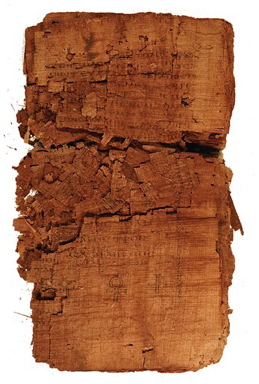
Perhaps since the the text is in Coptic it's normal to have the ankh. It just took me by surprise when I saw it in the magazine.
A couple of outrageous quotes:
The article cites Bart Ehrman as saying "This is big ... a lot of people are going to be upset." Well, probably not, Bart. If you go to http://news.google.com/ and do a simple search for "gospel of Judas," you'll find that majority of the articles listed (and there are hundreds) are fairly dismissive. It certainly doesn't seem that folks are getting all that upset over it.
Frieda Nussberger-Tchacos, the final buyer of the gospel, is quoted as saying "Everything is predestined. I myself was predestined by Judas to rehabilitate him."
Yeah... good luck with that...
Previous blogs on the Gospel of Judas:
The Gospel of Judas: What They Don't Want You to Know
My Argument Against the Gospel of Judas: Let Me Clarify for My Critics in Taipei
Irenaeus and the Gospel of Judas










